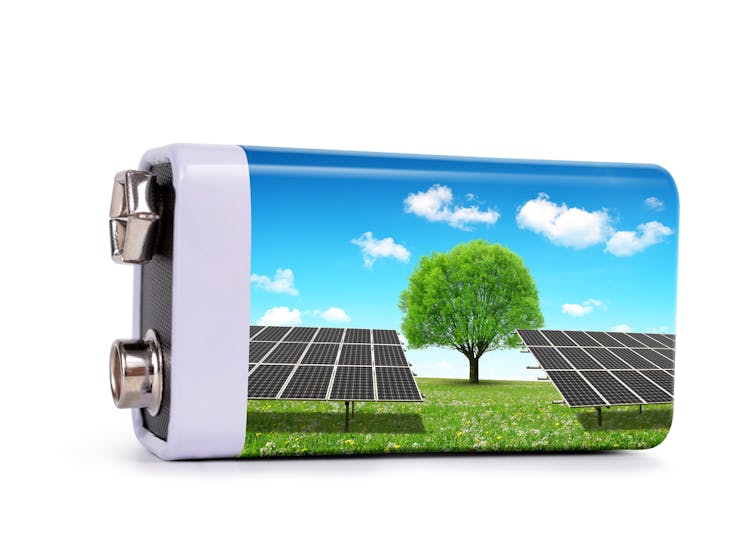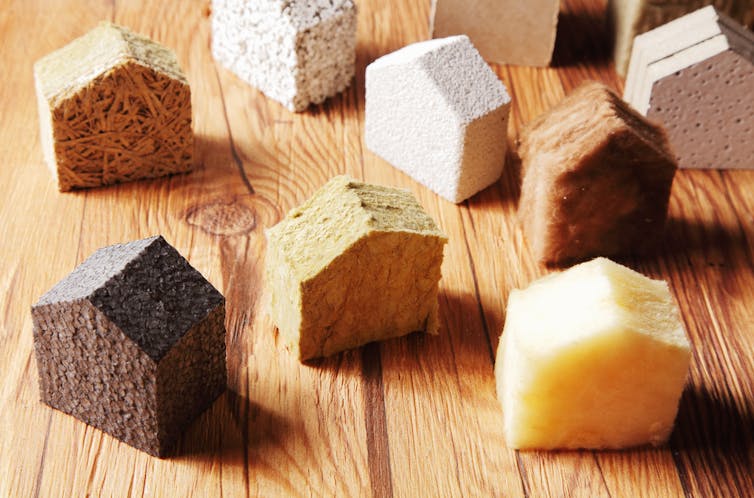Is it possible to live off-grid?

Off-grid mountain house. Shutterstock
Sharon George, Keele University
As interest grows in self-sufficient, sustainable communities, and fears over Europe’s reliance on gas imports increase, more and more people are considering moving “off-grid”.
Pioneering companies are already building radical high-tech eco-villages, with waiting lists for these homes numbering in the thousands. Technology is smarter, more efficient and cheaper than ever before, which makes these eco-homes a reality for those who can afford them. But has the technology become mainstream enough to be realistic for the rest of us?
Our gas and electricity supply infrastructures, called grids, are centralised systems that distribute energy to where it is needed. Supply and demand are carefully matched and with the grid often buys excess renewable energy from consumers to keep it fully fed during energy lulls.

Batteries and storage have become more advanced. Shutterstock
Detaching from this grid means losing that safety net – and this has long been the problem for those with off-grid aspirations. Until recently an off-grid life meant severely limiting energy use when the sun wasn’t shining or the wind wasn’t blowing. Now, energy storage technology is becoming so advanced that we can store excess rays and gusts for the darker and calmer hours, rather than sell the extra energy back to the grid. But given that the storage problem is being solved, the question of whether we can produce enough energy remains.
The key to producing enough energy to live off-grid is to use a range of solutions. The average family’s energy consumption varies depending on where they live. On the US mainland, for example, it is around 30 kilowatt hours a day but in Hawaii it is just half of this. In colder countries such as the UK, where the average family uses around 125 kilowatt hours a day, heating homes requires a lot of energy.
But there are many options out there to keep us warm, the simplest of which is burning biomass (wood and other organic matter). Solar thermal collectors and ground source heat pumps allow us to extract natural heat from our surroundings to heat water systems. These can be quite expensive to buy, costing several thousands of pounds but are efficient and, as a longer-term investment, will pay for themselves after several years. It’s also possible turn waste cooking oils into environmentally friendly biodiesel to be used as heating oil or vehicle fuel.
Going off-grid for our gas can even help us solve two problems at once. From dog poo to a famous London fatberg, businesses are making good use of our waste – and so can you. A home-ready anaerobic digester will turn your food waste, waste-water and sewage into enough gas to cook your meals. At around £700, any saving from the gas produced would not come close to breaking even for decades, but it is a great way to produce biogas and fertiliser while dealing with waste.
Satisfying the electricity needs of our modern lifestyles, wherever we live, is more tricky. Solar is currently the most popular choice – a typical system to power the average UK family home would cost around £8,000. Taking into account maintenance costs, you could break even within about eight years. Wind makes less sense for the individual household. A roof-mounted turbine provides less than a quarter of the roughly 45,000 kilowatt hours UK households use in a year, while if you’re fortunate enough to have the space for a full-size 6kW turbine, it’ll set you back at least £20,000 and could take the whole lifespan of the turbine to cover its costs.
So is going off grid affordable? Once off the grid it’s possible to use a mix of storage solutions and technology. For most of us, the cost of moving off-grid and setting up this freedom is still too big a barrier. The best solution would be a partial move away from dependence on the grid. If you have between £5,000-£8,000 to spend solar PV technology makes the most sense with the fastest payback and supplemented energy from wood-burning, especially if you can get a good deal on the panels and wood.
One way of cutting our grid-dependence that we can all afford is to simply use less energy. Our current energy use is highly wasteful – and there are a number of habits we can change here and now to make off grid living more viable and reduce our energy bill – regardless of whether we’re on or off the grid.
Changing habits
Turn down the heat. Heating water is one of the most intensive uses of energy in our homes. Just turning down the heating by a degree can shave around 10% off your heating bill.
Reduce energy used by lighting. Lighting accounts for around 15% of household electricity. Consider switching to LED lights – up to 90% more efficient than incandescent bulbs, their extra cost can be recouped in just a few months.
There are big gains to be made by changing the way you wash and dry your clothes. Switching to cold water can save up to 90% of the energy used in clothes washing (most washing powders are now designed to work at low temperatures), and drying clothes naturally wherever possible will help save almost as much energy as it took to wash them, and will reduce the need for energy-intensive ironing.

Insulate. Shutterstock
Capture the heat you use and create. Dealing with draughts and fitting loft insulation can prevent up to a quarter of the heat in your home escaping through the loft. Better still, insulate yourself. We heat our homes to more than four degrees warmer than we did 50 years ago. Reaching for an extra clothing layer instead.
![]() So, living off-grid is possible but not as affordable as you might think. We can use solar, wind, biomass and even biogas technologies. But cutting down what energy you do use and on waste will allow you to go further. Given that battery storage and other technologies are in an exciting era and as living off-grid becomes more socially desirable, it probably won’t be long until more people will be able to do it for less money.
So, living off-grid is possible but not as affordable as you might think. We can use solar, wind, biomass and even biogas technologies. But cutting down what energy you do use and on waste will allow you to go further. Given that battery storage and other technologies are in an exciting era and as living off-grid becomes more socially desirable, it probably won’t be long until more people will be able to do it for less money.
Sharon George, Lecturer in Environmental Science, Keele University
This article was originally published on The Conversation. Read the original article.
Most read
- Keele University partners with Telford College and NHS to teach new Nursing Associate apprenticeship in Shropshire
- Emotion aware chatbot developed by Keele scientists offers transformative potential for mental health care
- First study of its kind sheds new light on Britain’s ‘forgotten’ World War Two decoy sites
- Keele cardiologist travels to Ethiopia to improve care for heart patients
- Keele academic wins prestigious prize for short story set in Stoke-on-Trent
Contact us
Andy Cain,
Media Relations Manager
+44 1782 733857
Abby Swift,
Senior Communications Officer
+44 1782 734925
Adam Blakeman,
Press Officer
+44 7775 033274
Ashleigh Williams,
Senior Internal Communications Officer
Strategic Communications and Brand news@keele.ac.uk.

